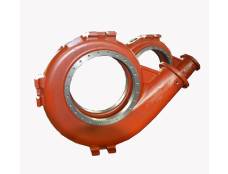+86 311 85258258
+86 311 85258258
Jan. 29, 2021
How To Solve These Defects In Ductile Iron Castings?
Ductile iron is an important casting metal material developed in my country in the past 40 years. Because the stress concentration caused by spheroidal graphite is small, and the fracturing effect on the matrix is also small, the tensile strength, plasticity, and toughness of ductile iron are higher than other cast irons. Compared with steel with corresponding structure, plasticity is lower than steel, fatigue strength is close to general medium carbon steel, yield ratio can reach 0 7~0.8, almost twice that of general carbon steel, and the cost is lower than steel, so its application increasingly widespread. Of course, ductile iron is not perfect. In addition to general casting defects, it will also produce some unique defects, such as shrinkage, slag inclusion, subcutaneous pores, poor spheroidization, and recession. These defects affect the performance of castings and increase the rejection rate of castings. In order to prevent the occurrence of these defects, it is necessary to analyze and precision cast them, summarize various influencing factors, and propose preventive measures, in order to effectively reduce the occurrence of defects and improve the mechanical properties and production efficiency of castings.
(1)Carbon equivalent: Increasing carbon content increases graphitization expansion and reduces shrinkage and porosity. In addition, increasing the carbon equivalent can also improve the fluidity of ductile iron, which is conducive to feeding. The empirical formula for producing high-quality castings is C%+1/7Si%>3 9%. However, when the carbon equivalent is increased, other defects such as graphite floating should not be caused in the casting.
(2)Phosphorus: The high phosphorus content in molten iron expands the solidification range. At the same time, the low melting point phosphorus eutectic cannot be recharged during the final solidification, and the shell of the casting becomes weaker, thus increasing shrinkage and porosity. The tendency to produce. Generally, the factory controls the phosphorus content to be less than 0 08%.
(3)Rare earth and magnesium: Too high a residual amount of rare earth will deteriorate the shape of graphite and reduce the spheroidization rate, so the content of rare earth should not be too high. Magnesium is an element that strongly stabilizes carbides and hinders graphitization. It can be seen that the amount of residual magnesium and the amount of residual rare-earth will increase the white mouth tendency of ductile iron and reduce the expansion of graphite. Therefore, when their content is higher, they will also increase the shrinkage and porosity tendency.
(4) Wall thickness: When a hard shell is formed on the surface of the casting, the higher the temperature of the molten metal inside, the greater the liquid shrinkage, and the volume of shrinkage will increase not only in absolute value but also in relative value. In addition, if the wall thickness changes too suddenly, the isolated thick section will not be fed, which will increase the tendency of shrinkage cavities and porosity.

(1) Control the composition of molten iron: maintain a high carbon equivalent (>39%); minimize the phosphorus content (<0 08%); reduce the amount of residual magnesium (<0 07%); use rare earth magnesium alloys for treatment, The residual amount of rare earth oxides is controlled within 0.02%~0.04%.
(2) The process design should ensure that the casting can continuously replenish the high-temperature molten metal from the riser during solidification. The size and quantity of the riser should be appropriate and strive to achieve sequential solidification.
(3) When necessary, use cold iron and subsidies to change the temperature distribution of the castings to facilitate sequential solidification.
(4) The pouring temperature should be 1300~1350℃, and the pouring time of a ladle of molten iron should not exceed 25min to avoid spheroidization and recession.
(5) Improve the compactness of the sand mold, generally not less than 90; the sand hits the sand uniformly, and the moisture content should not be too high to ensure that the mold has sufficient rigidity.
We are ductile iron pump suppliers. Please feel free to contact us.
PREVIOUS: Metal Casting
NEXT: How To Choose Gray Iron, Ductile Iron And Carbon Steel